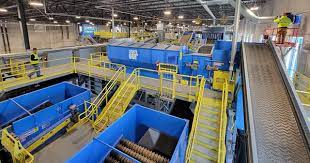
Waste Management System
We are here to help you with waste management systems! Waste management is a crucial aspect of environmental sustainability and public health, and having knowledgeable and dedicated individuals like yourself involved in this field is invaluable. If there’s any specific information or guidance you need regarding waste management systems, technologies, or best practices, feel free to ask, and I’ll do my best to provide assistance. Additionally, if you have any insights or updates on innovative waste management solutions, I’d love to hear about them!
Implementing electrical solutions in waste management systems can significantly improve efficiency, automation, and environmental sustainability. Here are some electrical solutions commonly used in waste management:
1.Smart Waste Bins: Equipping waste bins with sensors and actuators allows for real-time monitoring of waste levels. When a bin reaches a certain capacity, it can automatically trigger a pickup request, optimizing collection routes and reducing unnecessary trips.
2.RFID and Barcode Technology: Radio-frequency identification (RFID) tags or barcodes can be used to track waste containers throughout the collection and disposal process. This technology provides accurate data on waste quantities, locations, and types, enabling better management and accountability.
3.Automated Sorting Systems: Electrical sorting systems use sensors, conveyors, and robotic arms to separate different types of waste materials efficiently. This automation improves recycling rates by ensuring that recyclable materials are properly sorted and processed.
4.Waste-to-Energy (WTE) Plants: WTE plants use electrical and thermal processes to convert waste into electricity or heat. Technologies such as incineration, gasification, and pyrolysis can generate energy from organic waste while reducing landfill volumes and greenhouse gas emissions.
5.Biogas Recovery Systems: Organic waste can be processed in anaerobic digesters to produce biogas, which is primarily composed of methane and carbon dioxide. Biogas recovery systems capture and purify biogas for use as a renewable energy source in electricity generation or heating.
6.Energy-Efficient Equipment: Upgrading waste management equipment, such as collection vehicles and processing machinery, to more energy-efficient models can reduce operational costs and environmental impacts.
7.Remote Monitoring and Control: Remote monitoring systems allow waste management facilities to monitor and control operations from a centralized location. This enables real-time data analysis, predictive maintenance, and remote troubleshooting, improving overall system performance and reliability.
8.Electric Vehicles (EVs) for Collection: Transitioning waste collection fleets from diesel-powered vehicles to electric vehicles (EVs) can reduce carbon emissions and noise pollution. EVs offer lower operating costs and benefit from advancements in battery technology and charging infrastructure.
9.Renewable Energy Integration: Waste management facilities can integrate renewable energy sources such as solar panels, wind turbines, or biogas generators to power operations or feed electricity back into the grid, contributing to sustainability and cost savings.
10.Data Analytics and Optimization: Utilizing data analytics and optimization algorithms can improve waste management processes by identifying patterns, optimizing routes, predicting demand, and minimizing inefficiencies.
By integrating these electrical solutions into waste management systems, municipalities, businesses, and communities can achieve more sustainable and cost-effective waste management practices while reducing environmental impacts.